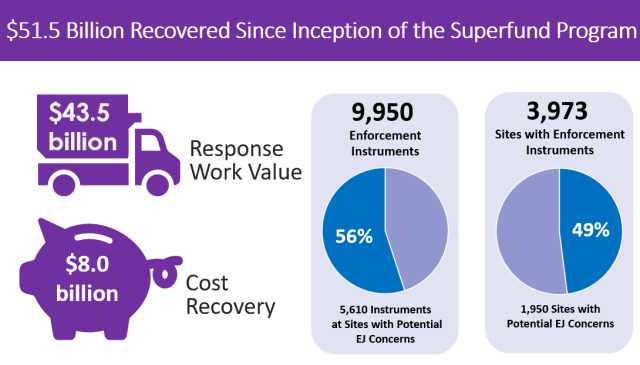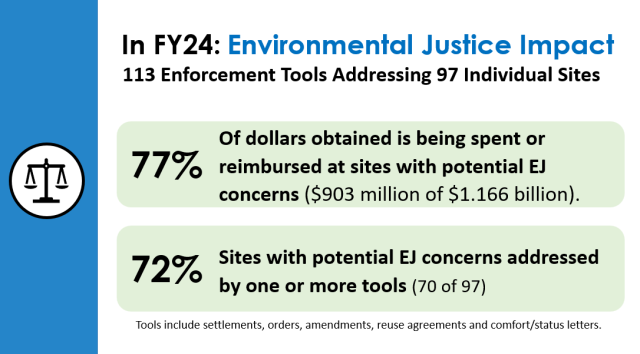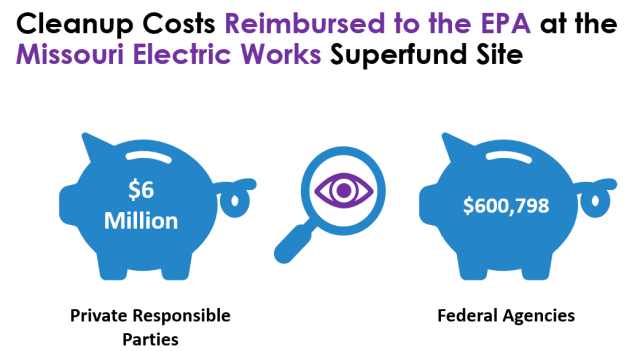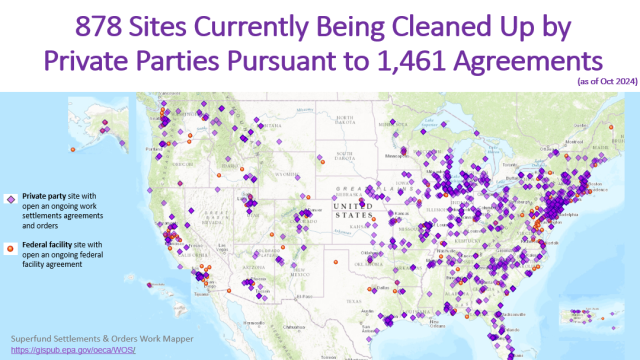Enforcement and Compliance Assurance Annual Results for FY 2024: Superfund Enforcement

The Environmental Protection Agency's Superfund enforcement program plays a crucial role to ensure the cleanup of contaminated sites and restore them to productive use, while promoting environmental justice in communities overburdened by pollution. Under the Comprehensive Environmental Response, Compensation, and Liability Act (CERCLA, commonly known as Superfund), EPA holds parties responsible either to clean up or pay for the cleanup of contamination that poses a risk to human health and the environment.
In FY 2024, the Superfund enforcement program continued its work to strengthen communities by ensuring that people live and work in healthy, risk-free spaces and to revitalize communities and remediate areas that are impacted by pollution.

Superfund enforcement cleanup agreements maximize EPA’s ability to address as many contaminated sites as possible through commitments by potentially responsible parties (PRPs), not taxpayer dollars, for cleaning up contaminated sites and potentially restoring them to productive use.
In FY 2024, EPA secured more than $1.1 billion in PRP commitments to either perform the cleanup work or to pay for future cleanup work, and $28.5 million for EPA’s past cleanup costs at 71 Superfund sites. Additionally, EPA billed PRPs approximately $81 million for EPA costs for overseeing PRP cleanup work, such as verifying sample results, ensuring compliance with all legal requirements, etc. EPA also issued 29 comfort/status letters to parties interested in revitalizing and redeveloping contaminated, potentially contaminated, and formerly contaminated property, supporting the return of Superfund sites to productive use.
FY 2024 accomplishments include:
- Completed 84 enforcement agreements (58 settlements, 7 orders, 12 settlement amendments, and 7 reuse agreements), along with 29 comfort/status letters at 97 unique Superfund sites for site investigations, cleanup, and returning property to productive reuse.
- PRPs agreed to spend or pay EPA approximately $1.166 billion to investigate the risks posed to people and the environment at contaminated sites, develop cleanup strategies and cleanup the contamination at Superfund sites. This includes $1.1 billion in estimated PRP cleanup costs and cashout dollars paid to EPA for future cleanup and $28.5 million to reimburse EPA for cleanup it already performed. Nearly 77% ($903 million) of the cleanup work is being spent or reimbursed at sites in communities overburdened by pollution.
- Finalized Superfund enforcement settlement agreements resulting in cleanups in communities where approximately 611,662 people live within a one-mile radius of a Superfund site with 96% (584,184) living in overburdened and underserved communities.
- Worked with seven EPA regional Superfund offices to conduct sampling and assessments to evaluate potential contamination at 11 major per- and polyfluoroalkyl (PFAS) manufacturing facilities across the nation as important steps towards holding accountable those who are responsible for the PFAS contamination at those facilities.
- Addressed cleanup at 72% of sites in communities overburdened by pollution (70 out of 97 sites).
With the addition of this fiscal year’s accomplishments, the Superfund enforcement program has, since its inception, obtained approximately $51.5 billion in PRP commitments for site cleanup and reimbursement of EPA’s costs spent in cleaning up sites, saving taxpayer dollars.

More information on the Superfund enforcement program is available on the agency’s website.
Protecting Communities by Ensuring Work Continues at the Most Complicated Sites
The Superfund program addresses some of the most contaminated sites in the Nation. Cleaning up these sites often is a complex, multi-phase process that takes many years to complete. Throughout the process, the Superfund enforcement program seeks to have PRPs perform or pay for the cleanup. EPA also considers how to incorporate sustainability principles and engages with nearby communities, particularly those disproportionately overburdened by pollution. The ultimate goals are to protect human health and the environment and return these contaminated sites to reuse. Examples of enforcement tools used at particularly complex Superfund sites to effectuate these goals include:
Cleanup of Gowanus Canal Superfund Site Continues with $369 Million Order

The Gowanus Canal, located in Brooklyn, NY, has been identified as one of the Nation’s most contaminated waterways. More than a dozen contaminants, including polycyclic aromatic hydrocarbons (PAHs), polychlorinated biphenyls (PCBs), and heavy metals are present at high levels. The communities located around the Canal have historically been overburdened by pollution, and the area is vulnerable to climate change impacts such as heat waves and extreme water events. In January 2020, EPA issued a unilateral administrative order (UAO) that required the largest six responsible parties at the Gowanus Canal Superfund site to dredge and cap accumulated sediments, as well as perform other required remedies.
On June 27, 2024, EPA amended the UAO and extended this dredge and cap work to the middle segment of the Canal, which has the highest level of contamination, at an estimated cost of $369 million. This is the second largest Superfund amendment in terms of dollar value ever.
The current cost of the overall cleanup plan for the Canal is estimated at over $2 billion. EPA continues to work closely with the Gowanus Canal Community Advisory Group (CAG), which was formed shortly after the Gowanus Canal’s Superfund listing in 2009, to address critical environmental justice and climate concerns. More information is available on the Gowanus Canal Superfund site profile web page and EPA Reaches New Milestone in Cleanup of the Gowanus Canal Superfund Site Cleanup press release.
Settlement Modification Adds $33 Million in Cleanup Work at Kalamazoo River Site

Due to industrial recycling of carbonless copy paper, the Kalamazoo River is estimated to be the most significant source of PCB contamination to Lake Michigan. On October 11, 2023, EPA, the state of Michigan, and NCR Corporation agreed to a modification to the 2020 cleanup settlement agreement, requiring NCR to conduct an additional $33.4 million worth of cleanup work. The additional work includes excavation and backfill of floodplain soil, targeted excavation of upstream bank soil, and capping. The cleanup work at the Kalamazoo River site will significantly reduce bird, mammal, and fish exposure to PCBs, stabilize the riverbank to prevent further intrusion of pollutants into the river, and enhance recreational activities throughout multiple communities. More information is available on the Kalamazoo River Superfund site profile webpage.
$96 million UAO Keeps Work on Schedule at Lower Duwamish Waterway Site

In July 2024, EPA issued a UAO to the Lower Duwamish Waterway Group (LDWG) (The Boeing Company, city of Seattle, and King County, WA) to start critical cleanup work at the Lower Duwamish Waterway Superfund site. The UAO, valued at $96 million, will allow in-river work to begin, while a settlement addressing the entire cleanup is expected to be finalized in the near future.
The UAO benefits the surrounding community by ensuring cleanup proceeds while further negotiations with PRPs are underway. The waterway poses a risk to human health and the environment and is contaminated with PCBs, arsenic, carcinogenic polycyclic aromatic hydrocarbons (cPAHs), dioxins, and furans. Eating fish and shellfish from the waterway and contact with the contaminated sediments also pose health risks. EPA issued this UAO to ensure work could begin during the construction window to protect migrating fish, moving cleanup forward and preserving access to waterway resources relied upon by area Tribes and communities. More information about the site is available on the Lower Duwamish River Superfund site profile web page.
Strengthening Communities While Protecting Human Health and the Environment

The Superfund enforcement program strengthens communities by ensuring that people live and work in a clean and healthy risk-free environment. The program works to revitalize communities and remediate areas that are impacted by pollution. Examples of settlement agreements focused on strengthening communities include:
Purchaser agrees to cleanup and redevelopment at the US Finishing/Cone Mills Superfund site in South Carolina

On February 27, 2024, EPA entered into a prospective purchaser agreement (PPA) with the Cone Mills Acquisition Group for the US Finishing/Cone Mills Superfund Site in Greenville, South Carolina. This more than $1 billion effort is the largest redevelopment project in the southeast, resulting in an areawide transformation with mixed-use recreational, commercial, and residential development. Under the agreement, the cleanup activities include surface and subsurface soil cleanup in the main facility, asbestos abatement, and building slab removal. The Purchaser will save U.S. taxpayers an estimated $3.5 million by performing cleanup actions at the former textile finishing and dyeing mill.
This agreement and the resulting site redevelopment demonstrate the effective partnership between federal, state, and local governments, a redeveloper, and the community to utilize multiple regulatory authorities to advance productive site cleanup and reuse. More information is available on the US Finishing/Cone Mills Superfund site profile webpage.
EPA Order at Chiquita Canyon Landfill Addresses Noxious Odors and Other Hazards

In 2023, nearly 6,800 odor complaints were received regarding the Chiquita Canyon Landfill, a 639-acre municipal solid waste landfill located in Castaic, Los Angeles County, CA. In May 2022, a significant subsurface oxidation reaction began, which lead to noxious odors and increased leachate production. The reaction expanded, covering 30 to 35 acres, and the leaching drew out more than 250,000 gallons of benzene from the landfill.
On February 21, 2024, EPA issued a UAO to Chiquita Canyon, LLC (CCL) requiring CCL to reduce off-site community impacts caused by the noxious odors and hazardous waste leachate and to reduce the smoldering or reaction event. In issuing the UAO, EPA intends for CCL to identify, investigate, remedy, and/or prevent potential endangerment to human health or the environment. Under the order, CCL is required to perform the following: properly manage the leachate; install temperature probes and a geomembrane landfill cover; and conduct increased air and water monitoring.
The estimated cost of the cleanup work is approximately $190 million and is part of a joint federal-state partnership to secure site clean-up. More information about the site is available on the agency’s Chiquita Canyon Landfill Superfund site profile webpage and the EPA Finds Chiquita Canyon Landfill Presents Imminent and Substantial Endangerment to Nearby Communities press release.
EPA Orders for the Cleanup of Contaminants at Koppers (Newport Plant) Site

In FY 2024, Beazer East Inc. provided its notice of intent to comply with the August 2023 EPA-issued UAO directing the company to address contamination from decades of wood treating operations. The work, valued at $40 million at the Koppers Co., Inc. Superfund (Newport Plant) site in Newport, DE, requires the company to develop and implement actions to avoid, minimize, or mitigate adverse effects that the cleanup work could cause to the historic property at the site.
The site contamination threatens ecological receptors, including organisms such as earthworms, insects, shelled organisms, fish and frog embryos, and plants. When finished, the cleanup work will protect these ecologically sensitive organisms from direct exposure and protect future potential industrial workers at the site, if the site is ever reused for industrial purposes. More information on the site is available on the Koppers Co., Inc. (Newport Plant) Superfund site profile webpage.
Additional Superfund Enforcement Case Examples
The following are examples of significant FY 2024 Superfund enforcement settlement agreements.
PPG Industries, Inc Agrees to Cleanup Work at Riverside Industrial Park Superfund Site in New Jersey

On September 4, 2024, EPA, the state of New Jersey, and PPG Industries, Inc. (PPG) reached a settlement agreement that requires PPG to clean up soil and groundwater contamination at the Riverside Industrial Park Superfund site in Newark, New Jersey. The contamination was likely caused by site operations, spills, dumping, and improper waste disposal, in an area historically overburdened by pollution.
The initial cleanup work, valued at $15.9 million, will include excavating contaminated soil, assessing vapor intrusion, implementing institutional controls, and monitoring groundwater. Further cleanup of groundwater will be completed under a separate, future enforcement agreement. Additionally, PPG also agreed to pay $2.88 million for past cleanup costs at the site. More information is available on the Riverside Industrial Park Superfund site profile webpage.
Multiple Parties to Pay Past and Future Cleanup Costs at the Missouri Electric Works Superfund Site

On April 29, 2024, EPA, 36 private parties, and three federal agencies agreed to a settlement to pay the United States and state of Missouri more than $6 million for the cost of previous cleanup work at the Missouri Electric Works Superfund site. The site, located in a light industrial and commercial district southwest of Cape Girardeau, MO, is approximately 1.6 miles from the Mississippi River. The private parties will pay slightly more than $6 million and the federal agencies will pay $600,798 to the United States. Additionally, the private parties will pay $625,261 and the federal agencies will pay $61,839 to the state of Missouri for EPA’s cleanup costs. More information is available on the Missouri Electric Works Superfund site profile and the Private and Federal Parties Pay Response Costs at Missouri Electric Works Superfund Site in MO press release.
Meeting the PFAS National Enforcement and Compliance Initiative Goals
EPA focuses its enforcement and compliance assurance resources on the most serious environmental violations by developing and implementing national program priorities, called National Enforcement and Compliance Initiatives or NECIs. On August 17, 2023, EPA announced its selection of six priority areas as the FY 2024 – 2027 National Enforcement and Compliance Initiatives (pdf) . Per- and polyfluoroalkyl substances or PFAS contamination is a significant priority for EPA and, for the first time, the agency is using a NECI to focus its enforcement and compliance assurance resources on addressing PFAS exposure, due to the toxicity and persistence of PFAS in the environment and the scope of the contamination nationwide.
Addressing Exposure to PFAS Contamination

The Addressing Exposure to PFAS NECI focuses on implementing EPA’s PFAS Strategic Roadmap (pdf) and holding responsible major manufacturers, federal facilities, and other industrial parties who significantly contributed to the release of PFAS contamination into the environment. As part of the NECI, the cleanup enforcement program will conduct preliminary assessments and site investigations at specific PFAS manufacturing facilities located across seven EPA Regions.
In FY 2024, EPA regional offices conducted sampling at eight facilities. In addition to those sampling efforts, the Superfund enforcement program compiled PFAS data for three additional facilities. This information will assist EPA in understanding the extent of PFAS contamination at these large facilities and enable early action to address any imminent or substantial endangerment posed by the chemicals. Eleven completed reports summarizing all historic, and ongoing operations, as well as all existing PFAS environmental data, were completed for the NECI in FY 2024.
Additionally, on April 19, 2024, EPA issued the PFAS Enforcement Discretion and Settlement Policy Under CERCLA. The policy was issued in a separate but parallel action to the agency’s final rule designating PFOA and PFOS as hazardous substances under Superfund. The enforcement discretion policy helps further the goals of the PFAS Strategic Roadmap, which seeks “to hold polluters and other responsible parties accountable for their actions and for PFAS remediation efforts.” Like existing enforcement discretion policies, the policy clarifies when EPA intends to use its Superfund enforcement authorities or decide not to pursue a particular party. The policy clarifies that EPA does not intend to pursue certain entities where equitable factors do not support seeking response actions or costs under CERCLA. More information on the PFOA/PFOS designation and policy is available in this former Biden-Harris Administration Finalizes Critical Rule to Clean up PFAS Contamination to Protect Public Health press release.
Superfund Enforcement Cleanup Work Map

EPA's Superfund Settlements and Work Order Map highlights the current cleanup work taking place at Superfund private party sites and federal facility sites across the country resulting from the agency’s enforcement work to negotiate cleanup settlement agreements or issue orders.
The data is current through September 30, 2024. The current map contains data on the cleanup work at 878 sites under 1,461 enforcement actions and orders valued at approximately $25 billion in estimated cleanup costs. Visit the Information about the Superfund Cleanup Work Map webpage for the map’s data overview, disclaimer language, and user guide.
